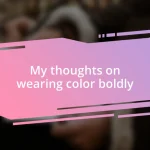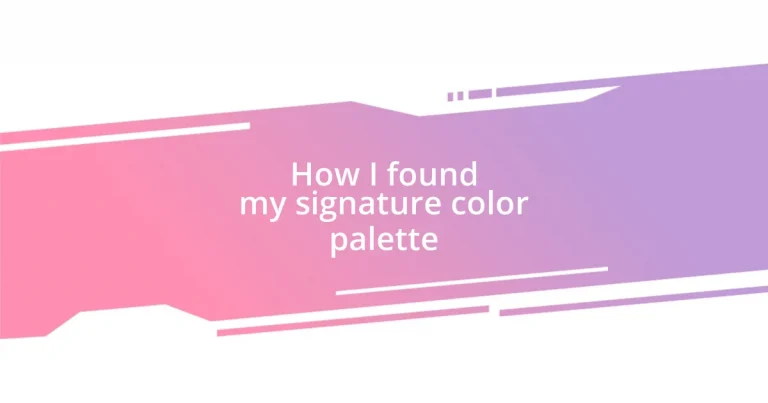Key takeaways:
- Understanding color theory, including the use of the color wheel, helps in curating a personal color palette that reflects emotions and personality.
- Exploring nature and personal memories can reveal emotional connections to colors, aiding in identifying one’s unique style.
- The process of creating a mood board and testing color swatches leads to finalizing a signature palette that harmonizes with one’s surroundings and expresses individuality.

Understanding color theory basics
Color theory is fascinating, serving as the foundation for how we perceive and interact with colors. It’s not just about what looks good together; it’s about the emotions colors evoke. Think about the last time you walked into a room painted bright yellow—didn’t it instantly lift your spirits? I still recall the first time I painted my studio a soft teal. It was as if the room exhaled, inviting creativity.
The color wheel is a vital tool, showing the relationships between different colors. Primary colors, like red, blue, and yellow, combine to create secondary colors such as green and purple. But have you ever pondered why certain colors make you feel calm while others energize you? It’s all about color harmony, which I learned to appreciate during a design class. Understanding how colors work together helped me curate a palette that truly represents my personality.
Complementary colors—those opposite each other on the wheel—create striking contrasts that can make a design pop. This was an eye-opener for me when I was experimenting with my artwork. I paired bright orange with deep blue and could see how they drew attention to each other. It made me wonder: how can the right color pairings elevate your own work or space? Embracing these basics of color theory has helped me refine my aesthetic, and maybe it could help you find your perfect color palette too.
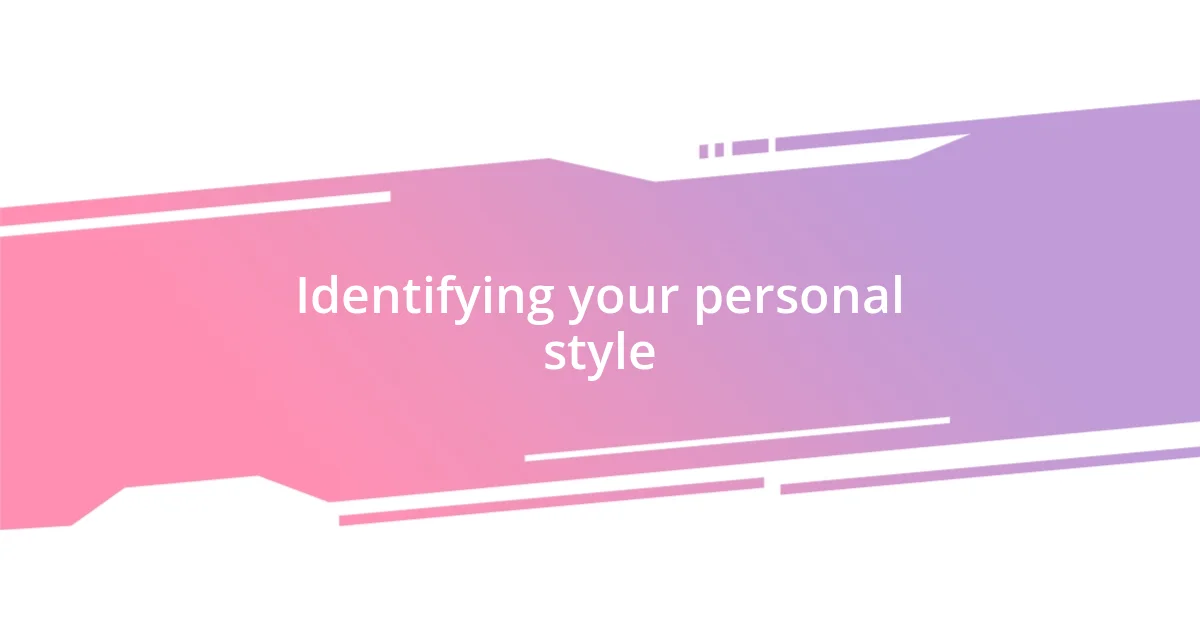
Identifying your personal style
To identify your personal style, start by examining what resonates with you emotionally. I often find myself drawn to the earthy tones of nature, which evoke a sense of calm and grounding. When I walk through a forest, the rich greens and browns inspire me, reminding me that simplicity can be powerful.
Another aspect to consider is the connection between colors and memories. For instance, I have childhood memories tied to vibrant orange. My grandmother’s kitchen was a warm, inviting space painted in that hue, filled with the aroma of her favorite spices. This emotional link has led me to incorporate orange into my color palette, as it invokes feelings of comfort and nostalgia.
Exploring your wardrobe can also reveal your color preferences. I noticed that whenever I wear shades of blue, I feel confident and composed. This simple act of paying attention to the colors that resonate with you can be a transformative experience in recognizing your signature style.
| Element | Personal Reflection |
|---|---|
| Nature Colors | Inspired by earthy tones; they provide a calming effect. |
| Emotional Connections | Childhood memories tied to vibrant orange evoke warmth and nostalgia. |
| Wardrobe Choices | Wearing blue enhances my confidence and composure. |
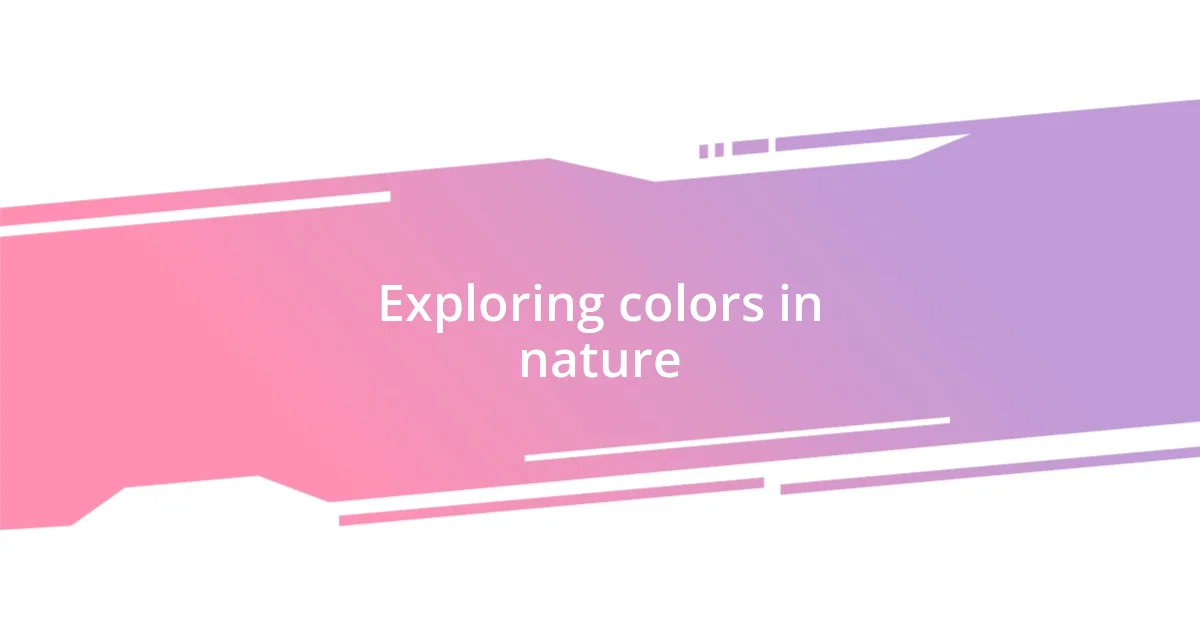
Exploring colors in nature
Exploring colors in nature has always been an exhilarating experience for me. I still remember hiking in the mountains one summer, surrounded by wildflowers of vibrant purples and yellows. Those hues sparked my creativity and helped me realize that nature’s palette is both vast and intimate, inviting me to explore my preferences further.
- A sunset can range from deep oranges to soft pinks, reminding me of fleeting moments of beauty.
- The refreshing greens of a spring meadow instantly calm my mind and feel like a breath of fresh air.
- The deep blues of the ocean evoke a sense of peace, leaving me feeling grounded yet inspired.
Every time I venture outdoors, I find shades that resonate with my mood. Encountering the striking contrast between the fiery red of autumn leaves against the cool gray of the sky often stirs a sense of wonder. It’s not just about observing colors; it’s about how they make me feel. Like when I stumbled upon a field of lavender, the purple spoke tranquility to my soul, urging me to embrace softer, muted tones in my palette. Nature has a beautiful way of guiding us toward the colors that truly reflect who we are.
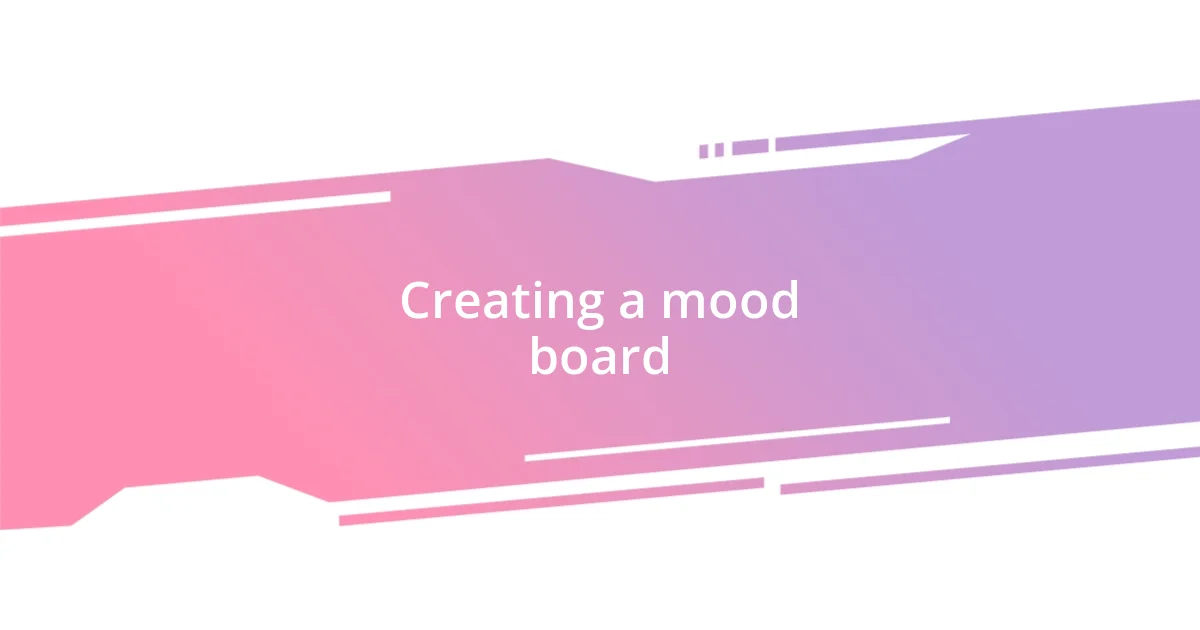
Creating a mood board
Creating a mood board is a delightful journey into self-discovery. I remember gathering images in a cozy coffee shop, flipping through magazines, and soon I was surrounded by snippets of colors, textures, and patterns that spoke to me. The process itself felt cathartic, almost like gathering pieces of my soul and arranging them on a canvas that reflected my unique essence.
As I curated my mood board, I found myself drawn to certain hues that evoked specific feelings. For example, I included a warm peach that reminded me of summers spent lounging in the sun, surrounded by laughter and family. Isn’t it fascinating how colors can transport us back to defining moments? I often think about how each color on my board is not just a shade, but a fragment of a memory that shapes my identity.
Once I had everything laid out, I was amazed at how cohesively they came together. It wasn’t just a collection; it was a visual representation of my aspirations and comfort zones. The rich burgundies paired beautifully with soft pastels, creating a sense of balance that felt just right for me. Have you ever experienced that moment when everything clicks? That feeling of clarity and alignment is why I cherish my mood board; it continually inspires me to explore my style further.
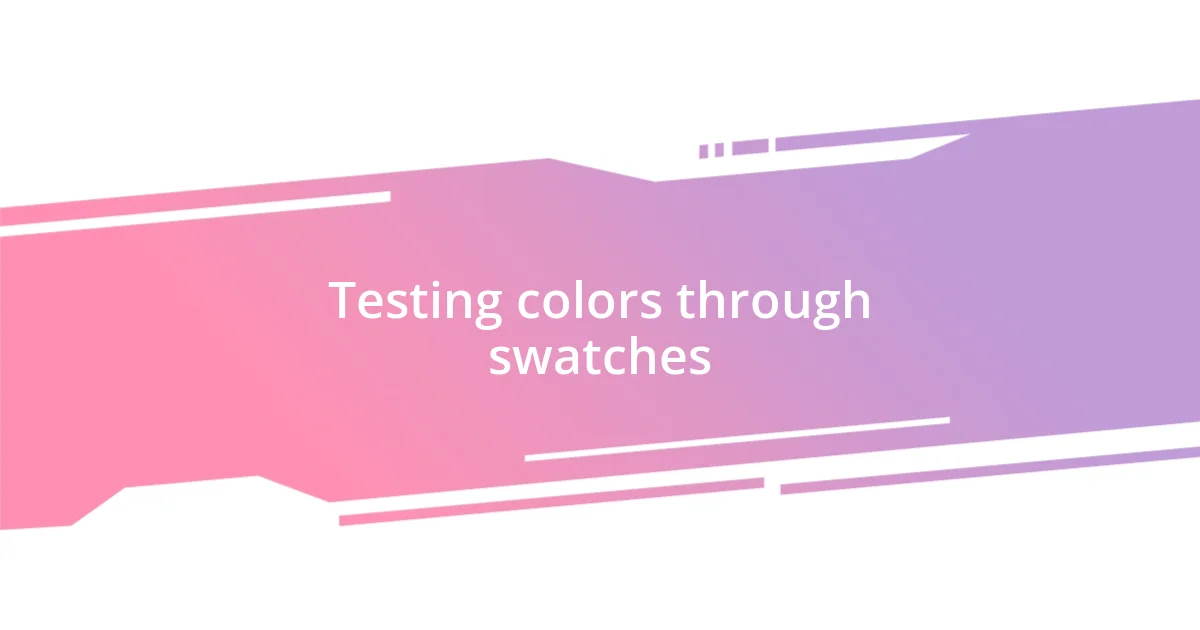
Testing colors through swatches
I learned that testing colors through swatches is an essential step in refining my signature palette. One afternoon, I laid out an array of paint swatches on my dining table, completely captivated by the potential each shade held. It was like exploring a treasure chest, each swatch inviting me to imagine a space or a moment that could be brought to life.
As I shifted the swatches around, I noticed how some colors seemed to vibrate together, while others clashed painfully. There was this moment when a soft sage green against a muted terracotta just clicked; it felt like a conversation between the colors. Have you ever mixed colors and felt that spark? For me, that delightful realization often guides my choices, reminding me that each combination reflects a part of who I am.
I also discovered the power of lighting in testing these swatches. I remember placing a bold cobalt blue swatch by my window at different times of the day and noticing how it transformed under the sunlight. It’s fascinating how a color can shift from vibrant to calm just by changing its environment. This experience taught me that choosing a palette isn’t just about the colors themselves, but also about how they interact with their surroundings and how they make me feel in those moments.
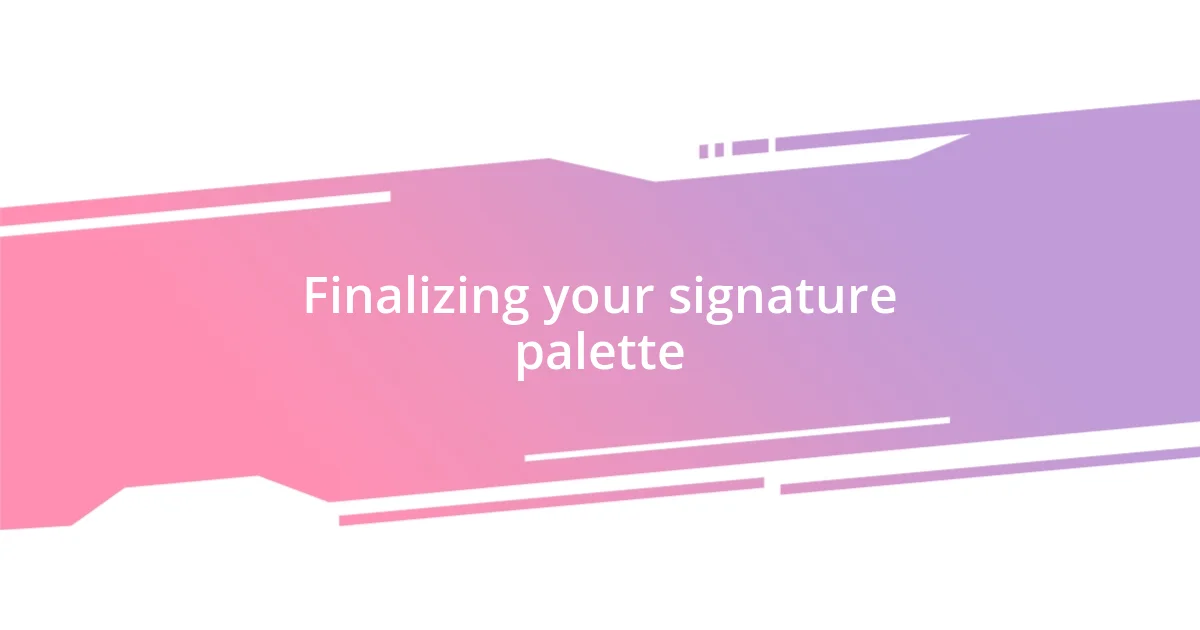
Finalizing your signature palette
After playfully arranging my mood board and testing countless swatches, finalizing my signature palette was like piecing together a beautiful puzzle. I remember sitting on my living room floor, surrounded by a rainbow of swatches, and suddenly, it all clicked. I was struck by the realization that the colors I gravitated toward weren’t just about aesthetics; they told a story about who I am. Have you ever had that moment where a color palette sings to your soul?
In those quiet moments of contemplation, I carefully selected three primary shades that harmonized perfectly. One lured me in with its calming ocean blue, reminiscent of serene beach days, while another bold deep mustard spoke to my adventurous spirit. I jotted down my reasons for choosing each shade, almost like a love letter to myself. This process taught me that my palette was not merely about choosing what looks good together, but it was an authentic expression of my journey.
As I finalized my choices, I also reflected on balance—how each hue complemented the others and contributed to the overall feeling. I found that adding a textured gray as a grounding element beautifully highlighted the vibrancy of the other colors. There’s something so rewarding about creating a color palette that feels cohesive and genuine; it becomes part of my visual signature, shaping my spaces and reflecting my personality seamlessly. Isn’t it fulfilling when your choices resonate with your identity?
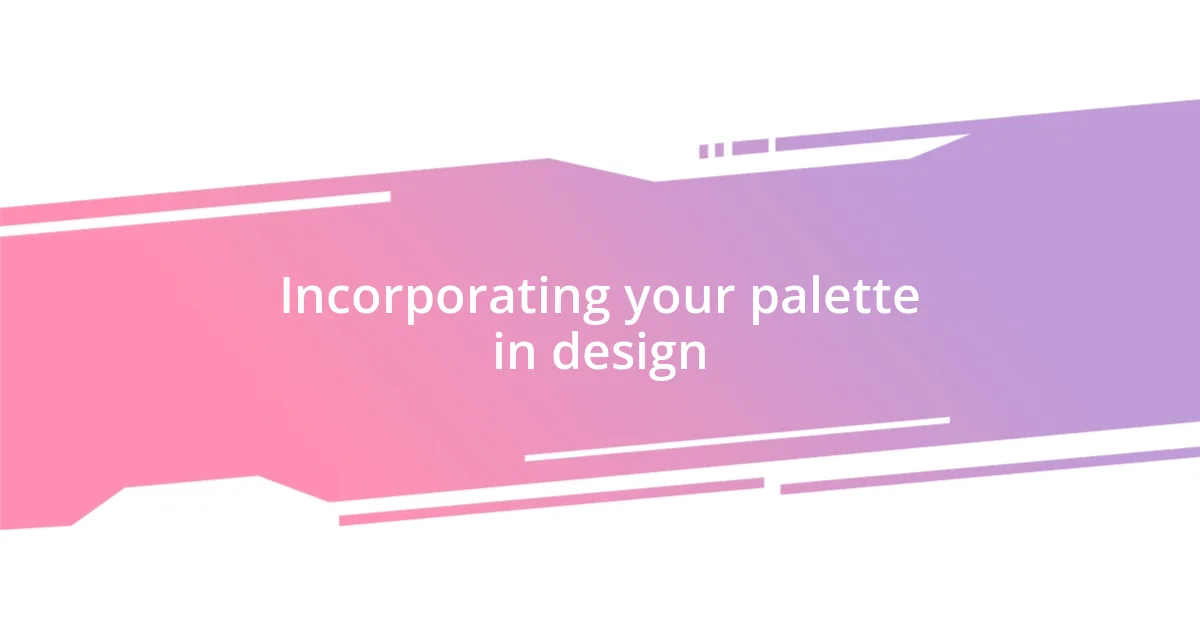
Incorporating your palette in design
When it comes to incorporating my color palette into design, I often start by considering the environment where the colors will live. I’ve experienced how a chosen shade can dramatically alter the mood of a room. For instance, I once painted my home office a soft lavender, and it became a sanctuary for creativity—so much so that I found myself spending hours there, fueled by inspiration. Have you ever noticed how certain colors can simply lift your spirits?
As I dive into actual design projects, I enjoy mixing different textures and materials that align with my color palette. When I redesigned my living room, I introduced a plush mustard yellow couch that became an instant conversation starter. Pairing it with deep navy pillows added depth, and I loved how visitors often marveled at how the colors danced together. How do your favorite textures blend with the colors you love? It’s like crafting a visual story that both tells and holds an emotional space.
Finally, I focus on creating focal points that showcase my palette beautifully. I remember hanging a large piece of art that featured the blues and yellows from my collection; it became such a striking centerpiece in the room. The artwork not only tied the colors together but invited dialogue among anyone who walked in. I believe that your design choices should encourage connections—what elements in your space spark conversation or make you feel at home?











